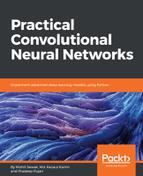Let's take another example. You are watching the movie 101 Dalmatians, and you want to know how many Dalmatians you can actually count in a given movie scene from that movie. Image Classification could, at best, tell you that there is at least one dog or one Dalmatian (depending upon which level you have trained your classifier for), but not exactly how many of them there are.
Another issue with classification-based models is that they do not tell you where the identified entity in the image is. Many times, this is very important. Say, for example, you saw your neighbor's dog playing with him (Person) and his cat. You took a snap of them and wanted to extract the image of the dog from there to search on the web for its breed or similar dogs like it. The only problem here is that searching the whole image might not work, and without identifying individual objects from the image, you have to do the cut-extract-search job manually for this task, as shown in the following image:

So, you essentially need a technique that not only identifies the entities in an image but also tells you their placement in the image. This is what is called object detection. Object detection gives you bounding boxes and class labels (along with the probability of detection) of all the entities identified in an image. The output of this system can be used to empower multiple advanced use cases that work on the specific class of the objects detected.
Take, for example, the Facial Recognition feature that you have in Facebook, Google Photos, and many other similar apps. In it, before you identify who is there in an image taken in at a party, you need to detect all the faces in that image; then you can pass these faces through your face recognition/classification module to get/classify their names. So, the Object nomenclature in object detection is not limited to linguistic entities but includes anything that has specific boundaries and enough data to train the system, as shown in the following image:

Now, if you want to find out how many of the guests present at your party were actually enjoying it, you can even run an object detection for Smiling Faces or a Smile Detector. There are very powerful and efficient trained models of object detectors available for most of the detectable human body parts (eye, face, upper body, and so on), popular human expressions (such as a smile), and many other general objects as well. So, the next time you use the Smile Shutter on your smartphone (a feature made to automatically click the image when most of the faces in the scene are detected as smiling), you know what is powering this feature.
